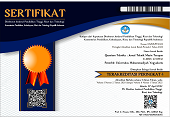Perancangan Polybag Knockdown Dengan Material Polyethylene Terephthalate (PET)
Abstract
Keywords
Full Text:
PDFReferences
Dwiratna, S., Widyasanti, A., & Rahmah, D. M. 2016. Pemanfaatan lahan pekarangan dengan menerapkan konsep kawasan rumah pangan lestari. Dharmakarya, 5(1).
Fitriyani, A., Hidayah, N. N., & Shalima, I. 2021. Optimalisasi Lahan Pekarangan Menggunakan Sistem Polybag dan Vertikultur Untuk Mendukung Ketahanan Pangan Keluarga. Jurnal Pengabdian kepada Masyarakat Abdipraja, 2(1), 2745-8415.
Pasir, S., Hakim, M. S. 2014. Penyuluhanpenanamansayuran dengan mediapolybag. Asian Journal of Innovation and Entrepreneurship, 3(03), 159-163.
Andayani, N., Arista, S., Safitri, D., & Wardani, W. K. 2020, June. Budidaya Putsa/Apel India di Daerah Pesisir. In PROSIDING SEMINAR NASIONAL IPPeMas (Vol. 1, No. 1, pp. 771-779).
Hidayat, Y. A., Kiranamahsa, S., & Zamal, M. A. 2019. A study of plastic waste management effectiveness in Indonesia industries. AIMS Energy, 7(3), 350-370.
Beitz, W., Pahl, G., & Grote, K. 1996. Engineering design: a systematic approach. Mrs Bulletin, 71.
Harsokoesoemo, H. D. 2004. Pengantar Perancangan Teknik: Perancangan Produk. Bandung: ITB.
Yudha, V., & Nugroho, N. 2020. Rancang Bangun Mesin Perajang Singkong dengan Pendorong Pegas. Quantum Teknika: Jurnal Teknik Mesin Terapan, 2(1), 20-26.
DOI: https://doi.org/10.18196/jqt.v4i1.16093
Refbacks
- There are currently no refbacks.
Copyright (c) 2022 Quantum Teknika : Jurnal Teknik Mesin Terapan

This work is licensed under a Creative Commons Attribution-NonCommercial 4.0 International License.
Quantum Teknika : Jurnal Teknik Mesin Terapan is indexed by :
Office:
Editorial of Quantum Teknika, Building D, Jl. Brawijaya, Tamantirto, Kasihan, Bantul, Yogyakarta.Telp: (0274) 387656
Fax: (0274) 387646
WA: +62896-7470-8638 (Mirza Yusuf)
Email: jqt@umy.ac.id

Quantum Teknika : Jurnal Teknik Mesin Terapan is licensed under a Creative Commons Attribution-NonCommercial 4.0 International License.















.png)